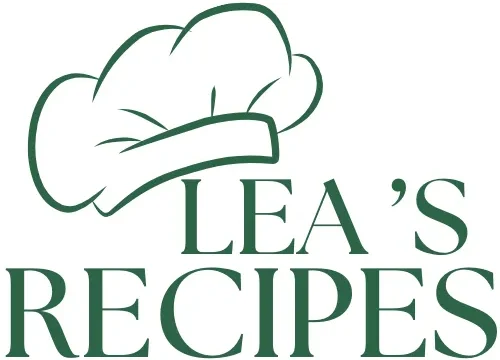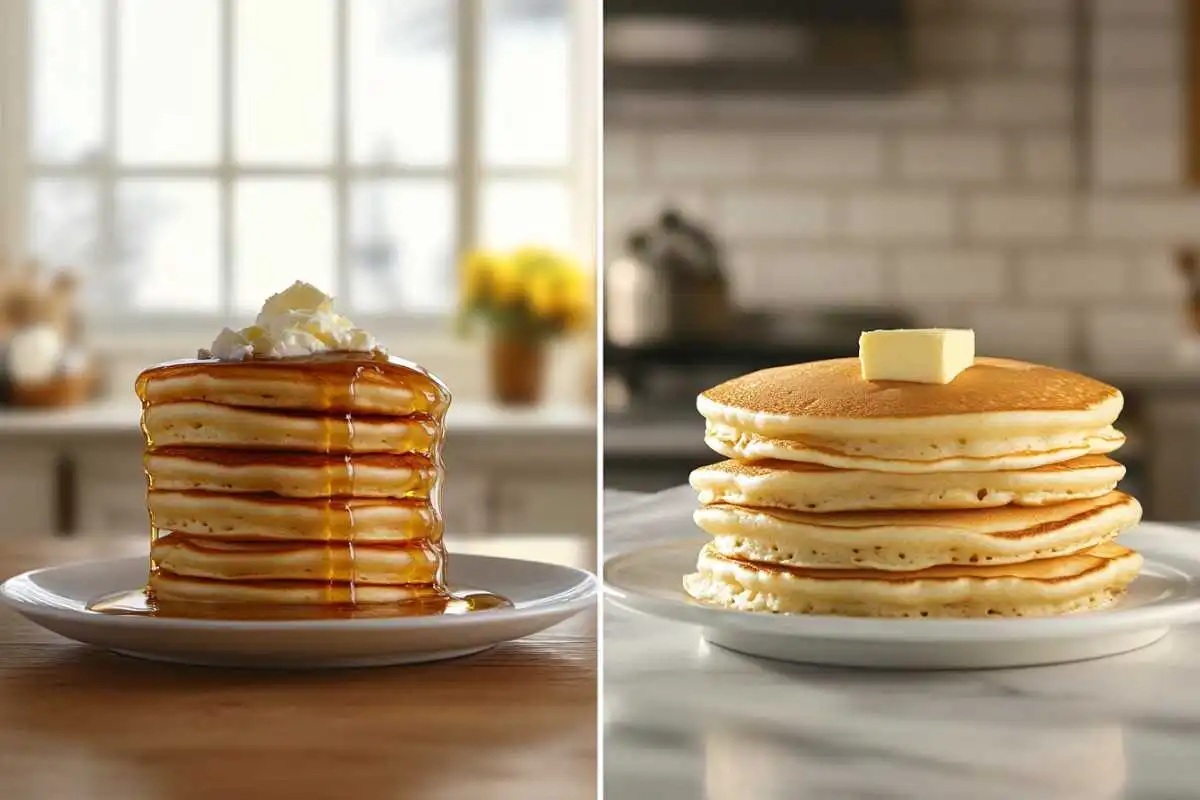Hotcakes and pancakes are breakfast favorites enjoyed worldwide, but are they truly the same? While they share similar ingredients and preparation methods, subtle differences in texture, flavor, and regional traditions set them apart. Understanding the difference between hotcake and pancake is more than just semantics—it’s about recognizing the unique characteristics that make each special.
Whether you’re preparing a quick breakfast or an indulgent brunch, knowing these differences can help you choose the right dish for any occasion. From their cultural roots to their perfect toppings, let’s dive into what makes hotcakes and pancakes stand out on your breakfast table.
Understanding the Difference Between Hotcake and Pancake
Hotcakes and pancakes are often grouped together in breakfast conversations, yet they each have distinct traits that set them apart. From texture and flavor to preparation techniques, understanding the difference between hotcake and pancake can transform how you approach these beloved dishes in your kitchen.
What Are Pancakes?
Pancakes are thin, fluffy cakes made from a simple batter of flour, eggs, milk, and baking powder. They are widely enjoyed for their light texture and versatility, often served with classic toppings like maple syrup and butter.
To explore creative variations for breakfast, check out our easy sourdough bagel recipe, which offers a tangy, chewy alternative to sweet breakfast dishes.
Key Features of Pancakes:
- Texture: Light and airy due to the leavening effect of baking powder or baking soda.
- Thickness: Relatively thin and flat, making them quick to cook.
- Flavor: Neutral, allowing for both sweet and savory pairings.
Pancakes are often associated with special breakfasts or brunches, offering a blank canvas for a variety of toppings.
What Are Hotcakes?
Hotcakes, on the other hand, are thicker and denser versions of pancakes. The term “hotcakes” is often used interchangeably with pancakes in the United States, particularly in the South and in diner culture. However, their defining characteristics make them stand out.
Key Features of Hotcakes:
- Texture: Denser and more substantial, with a slightly chewy bite.
- Thickness: Thicker than pancakes, providing a heartier eating experience.
- Flavor: Slightly sweeter, even without toppings, due to a higher sugar content in the batter.
To experiment with making your own hotcakes, try the hotcake mix recipe for a quick and delicious breakfast solution.
The Difference Between Hotcake and Pancake: Ingredients
Although both dishes share similar base ingredients, subtle differences in their ratios create noticeable variations in texture and flavor.
Pancakes:
- Use a higher liquid-to-flour ratio, resulting in a thinner batter.
- Often incorporate buttermilk for a tangy flavor and fluffiness.
- Sugar is optional and typically minimal, keeping the flavor neutral.
Hotcakes:
- Lower liquid-to-flour ratio, leading to a thicker, denser batter.
- Often include additional sugar or sweeteners, creating a naturally sweet taste.
- Sometimes use self-rising flour, which adds both leavening and flavor.
For ideas on balancing flavors and ingredients in cooking, check out our chimichurri tomato pizza recipe, which demonstrates how simple ingredient swaps can transform a dish.
Texture and Thickness: The Biggest Distinction
When it comes to the difference between hotcake and pancake, texture and thickness are perhaps the most noticeable factors.
Pancakes:
- The lighter texture comes from a higher proportion of liquid, making the batter spread thinly on the griddle.
- Cook quickly due to their thinness, often ready to flip within a minute or two.
Hotcakes:
- Their dense texture comes from a thicker batter and sometimes longer cooking times at lower heat.
- Retain their shape and rise more substantially on the griddle, creating a fluffy, cake-like consistency.
These distinctions make hotcakes ideal for holding heavier toppings like fruit compotes or savory spreads, while pancakes shine with lighter, syrup-based accompaniments.
Flavor Profiles: Sweet vs. Neutral
Another key aspect of the difference between hotcake and pancake lies in their flavor profiles:
- Pancakes: Neutral and versatile, perfect for experimenting with both sweet and savory toppings.
- Hotcakes: Slightly sweet on their own, offering a more indulgent flavor even without extra toppings.
Explore sweet and savory options with the crab brulee recipe to see how contrasting flavors can elevate simple dishes.
A Choice Based on Preference
Understanding the difference between hotcake and pancake can help you tailor your breakfast to suit your preferences. If you enjoy light and fluffy, pancakes may be your go-to. For a denser, heartier breakfast, hotcakes might hit the spot. The key is knowing when to choose each and how to customize them with the right ingredients and toppings.
For more ideas on crafting perfect breakfast dishes, visit our guide to the ingredients to mix into pasta for inspiration on balancing flavors and textures in creative ways.
Cultural and Regional Perspectives on the Difference Between Hotcake and Pancake
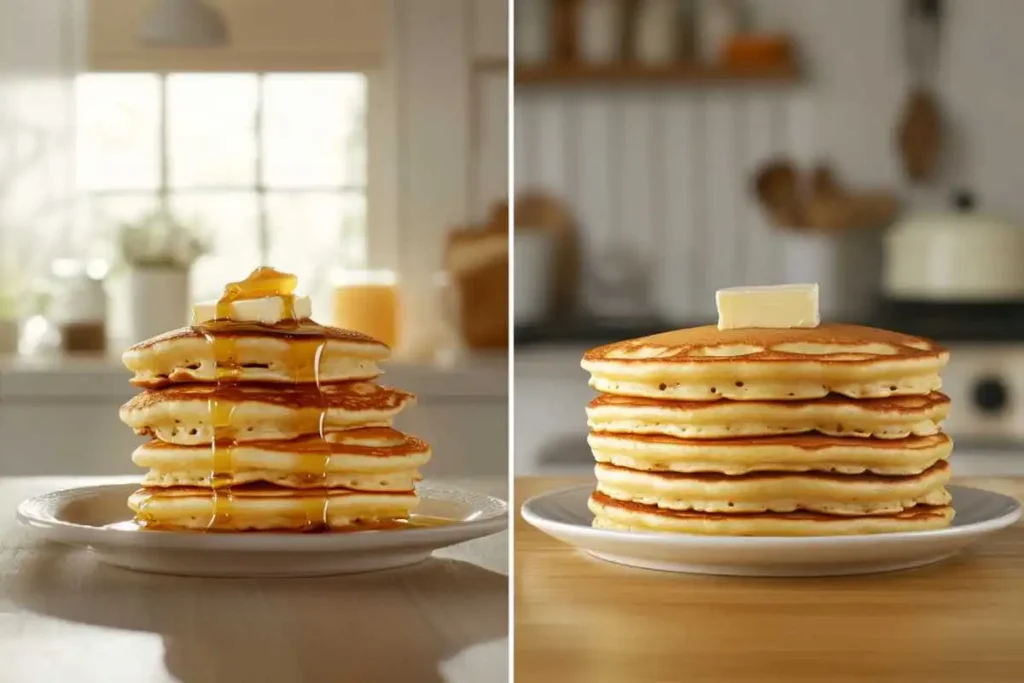
While hotcakes and pancakes are beloved across the globe, their terminology and preparation vary depending on cultural and regional traditions. These differences further highlight the difference between hotcake and pancake, providing insight into how each dish has evolved to suit diverse tastes.
Regional Variations of Pancakes
Pancakes have been embraced by numerous cultures, with each adding its unique twist:
- American Pancakes: Thick and fluffy, often served with maple syrup, butter, and fruits.
- French Crêpes: Thin and delicate, these are more akin to flatbreads and are filled with sweet or savory ingredients.
- Japanese Soufflé Pancakes: Ultra-thick and airy, thanks to whipped egg whites incorporated into the batter.
For those intrigued by innovative breakfast ideas, explore our hotcake mix recipe to create a denser, heartier version of the traditional pancake.
Pancakes in Popular Culture
In the United States, pancakes often symbolize a comforting, family-oriented breakfast. They are celebrated on occasions like Shrove Tuesday (also known as Pancake Day) and are a staple in diners. Their neutral flavor makes them the perfect canvas for experimentation, much like the adaptable nature of the chimichurri tomato pizza recipe, which blends traditional and modern flavors.
Hotcakes: A Regional Specialty
Hotcakes, often synonymous with pancakes in North America, have a few distinctions based on local preferences. They are a hallmark of American diner culture, particularly in the South, where hearty breakfasts reign supreme.
Why McDonald’s Uses “Hotcakes”
McDonald’s uses “hotcakes” instead of “pancakes” as a marketing choice, leaning into regional language preferences. This subtle distinction helps the brand connect with its audience, especially in areas where “hotcakes” are more commonly used.
For a similar regional influence on terminology and flavor, check out our guide to the most British cake, which dives into how geography shapes culinary trends.
Global Counterparts
In other parts of the world, similar dishes to hotcakes include:
- Drop Scones (Scotland): Thicker and smaller than American pancakes, often served with jam or clotted cream.
- Johnnycakes (Caribbean): Made with cornmeal instead of flour, giving them a distinctive texture and flavor.
Nutritional Differences Between Hotcakes and Pancakes
The difference between hotcake and pancake also extends to their nutritional profiles, influenced by ingredient proportions and preparation methods.
Pancakes:
- Calories: Lower per serving compared to hotcakes, thanks to their thinner, lighter nature.
- Sugar Content: Minimal unless sweeteners or toppings are added.
- Dietary Flexibility: Can easily be made healthier by substituting whole-grain flours or reducing sugar.
For a recipe focused on balanced nutrition, consider the ingredients to mix into pasta, which demonstrates how thoughtful substitutions can enhance health benefits.
Hotcakes:
- Calories: Higher due to additional sugar and a denser batter.
- Sugar Content: Sweeter batter may reduce the need for sugary toppings.
- Hearty Portions: Often more filling, making them ideal for energy-packed breakfasts.
Preparation Methods Highlighting the Difference Between Hotcake and Pancake
Pancake Preparation Tips:
- Mixing the Batter:
- Combine dry and wet ingredients separately before gently folding them together.
- Avoid overmixing to maintain the batter’s light consistency.
- Cooking Technique:
- Heat a griddle or pan over medium heat and lightly grease it.
- Pour small amounts of batter, flipping once bubbles appear on the surface.
Hotcake Preparation Tips:
- Thicker Batter:
- Adjust the liquid-to-flour ratio to create a denser batter.
- Rest the batter for a few minutes to allow it to thicken further.
- Low and Slow Cooking:
- Use lower heat to cook hotcakes evenly, ensuring the center is fully done without burning the exterior.
For guidance on achieving perfect results with alternative batters, refer to slice-or-piece-of-bread, which explores how subtle preparation differences can impact final textures.
Popular Toppings and Pairings for Hotcakes and Pancakes
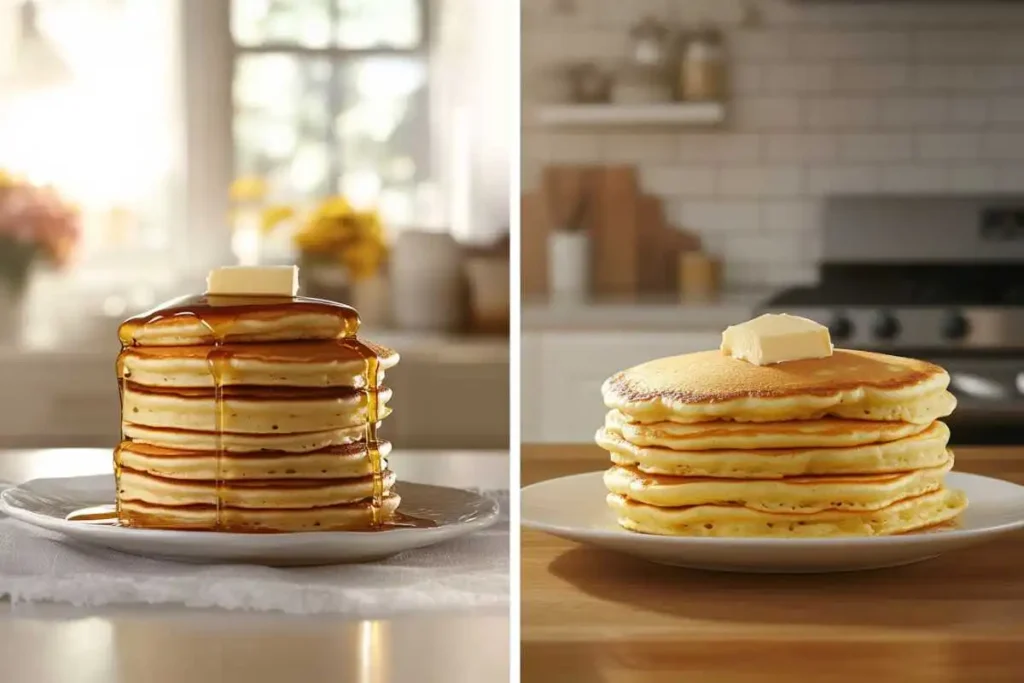
Both hotcakes and pancakes lend themselves to endless topping possibilities. The toppings you choose can further emphasize the difference between hotcake and pancake.
Pancake Toppings:
- Sweet Options: Maple syrup, honey, fresh fruit, whipped cream.
- Savory Pairings: Bacon, eggs, smoked salmon.
Hotcake Toppings:
- Sweet Additions: Butter, molasses, fruit compotes.
- Hearty Sides: Sausage, scrambled eggs, or creamy spreads like peanut butter.
For creative topping ideas, explore our roasted apricots salad recipes, showcasing how fruit can elevate any dish.
Celebrating the Unique Features of Hotcakes and Pancakes
Understanding the difference between hotcake and pancake enables you to appreciate their unique textures, flavors, and cultural significance. Whether you prefer the light, fluffy nature of pancakes or the denser, sweeter experience of hotcakes, both offer endless opportunities for customization and enjoyment.
For further inspiration on versatile recipes, dive into our garlic parmesan chicken pasta recipe to explore creative ways to balance ingredients for a satisfying meal. With this knowledge, you can confidently prepare the perfect breakfast for any occasion.
Practical Applications of the Difference Between Hotcake and Pancake
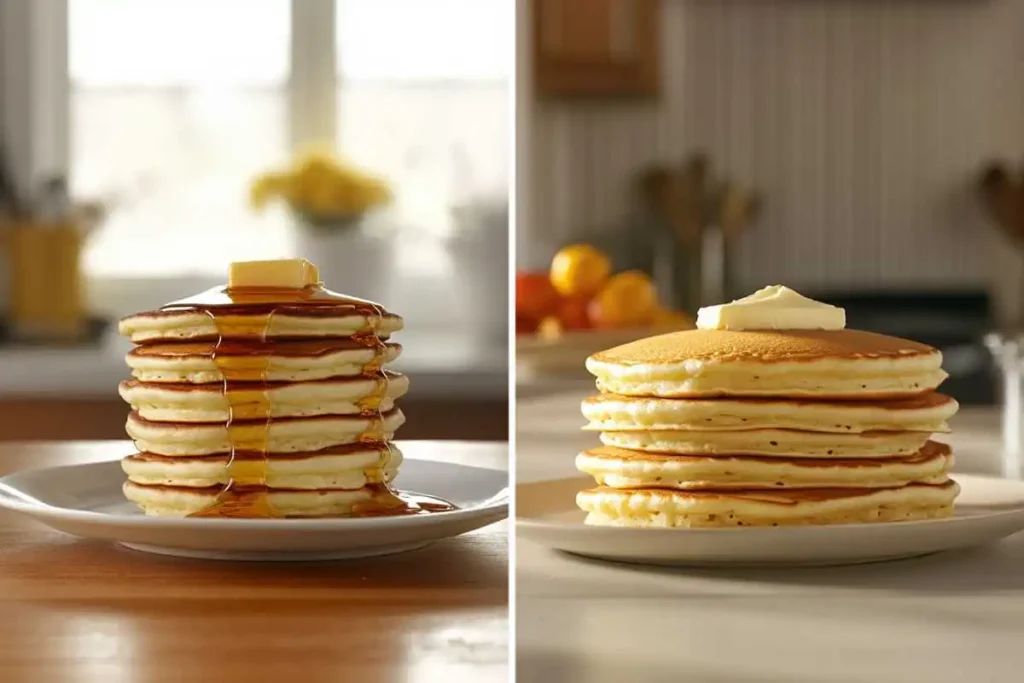
Understanding the difference between hotcake and pancake isn’t just about identifying their texture or sweetness—it also involves knowing how to use them in diverse recipes, serve them with the right accompaniments, and customize them for unique occasions. This section explores practical ways to incorporate both into your breakfast menu and beyond.
Adapting Recipes for Hotcakes and Pancakes
One of the most significant advantages of understanding the difference between hotcake and pancake is the ability to adapt recipes based on preferences, dietary needs, or creative inspiration.
Adjusting for Pancakes
- For Lighter Pancakes:
- Use buttermilk to enhance fluffiness and add a tangy flavor.
- Sift dry ingredients to aerate the batter.
- For Healthier Options:
- Swap all-purpose flour for whole-grain or almond flour.
- Reduce sugar and rely on natural sweetness from toppings like fruits or honey.
Explore how balanced ingredients transform a dish in our garlic parmesan chicken pasta recipe, perfect for creating healthier meals.
Adjusting for Hotcakes
- For Denser Hotcakes:
- Incorporate self-rising flour for a natural lift.
- Increase sugar slightly for a sweeter batter.
- For Vegan Hotcakes:
- Use plant-based milk like almond or oat milk.
- Replace eggs with flaxseed or chia seed mixtures.
For more substitution ideas, refer to ingredients to mix into pasta, which shows how simple ingredient swaps can yield creative results.
Serving Hotcakes and Pancakes for Different Occasions
Pancakes for Everyday Breakfasts
Pancakes are quick to prepare, making them ideal for busy mornings. Their versatility means you can easily adjust the flavor profile to match the season or occasion:
- Sweet Breakfasts: Add chocolate chips or blueberries to the batter.
- Savory Pairings: Serve with scrambled eggs or smoked salmon.
Check out slice-or-piece-of-bread for tips on balancing sweet and savory flavors in breakfast recipes.
Hotcakes for Special Occasions
Hotcakes’ denser texture makes them a standout option for celebratory breakfasts or brunches:
- For Birthdays or Anniversaries: Stack hotcakes high, layer them with whipped cream and fresh fruit, and drizzle with maple syrup.
- For Holiday Brunches: Add festive flavors like Cinnamon or nutmeg to the batter.
For a sweet dish that’s just as special, try our roasted apricots salad recipes for a unique twist.
The Role of Toppings in Highlighting Differences
Pancake Toppings
Pancakes’ neutral flavor allows for a variety of toppings:
- Traditional Toppings: Maple syrup, butter, powdered sugar.
- Healthy Additions: Greek yogurt, fresh berries, granola.
Hotcake Toppings
Hotcakes’ natural sweetness pairs well with both classic and bold toppings:
- Decadent Options: Caramel sauce, toasted coconut, chocolate shavings.
- Savory Combinations: Cream cheese, crispy bacon, sautéed mushrooms.
Discover how contrasting flavors can elevate a dish in our chimichurri tomato pizza recipe, which blends sweet and savory elements seamlessly.
FAQs About the Difference Between Hotcake and Pancake
Are Hotcakes and Pancakes the Same?
While similar, hotcakes are thicker, denser, and slightly sweeter than pancakes. Pancakes are lighter and fluffier, making them ideal for quick-cooking breakfasts.
Why Does McDonald’s Call Their Pancakes Hotcakes?
The term “hotcakes” aligns with American diner culture and resonates with customers who associate it with hearty breakfasts.
Can You Use Pancake Mix for Hotcakes?
Yes, but adjustments are needed. Add less liquid to the mix and slightly increase sugar for the denser, sweeter texture of hotcakes.
For a deeper dive into how terms and preparation impact recipes, explore our the most British cake article.
The Difference Between Hotcake and Pancake: Which Should You Choose?
Ultimately, deciding between hotcakes and pancakes depends on your personal preferences and the occasion. Pancakes are versatile and quick, perfect for everyday breakfasts. Hotcakes, with their hearty texture and rich flavor, are a great choice for indulgent meals or special celebrations.
For more culinary inspiration, try our crab brulee recipe to explore how subtle variations in ingredients and preparation create standout dishes. Understanding these differences allows you to enjoy the best of both worlds, tailored to your tastes and occasions.
